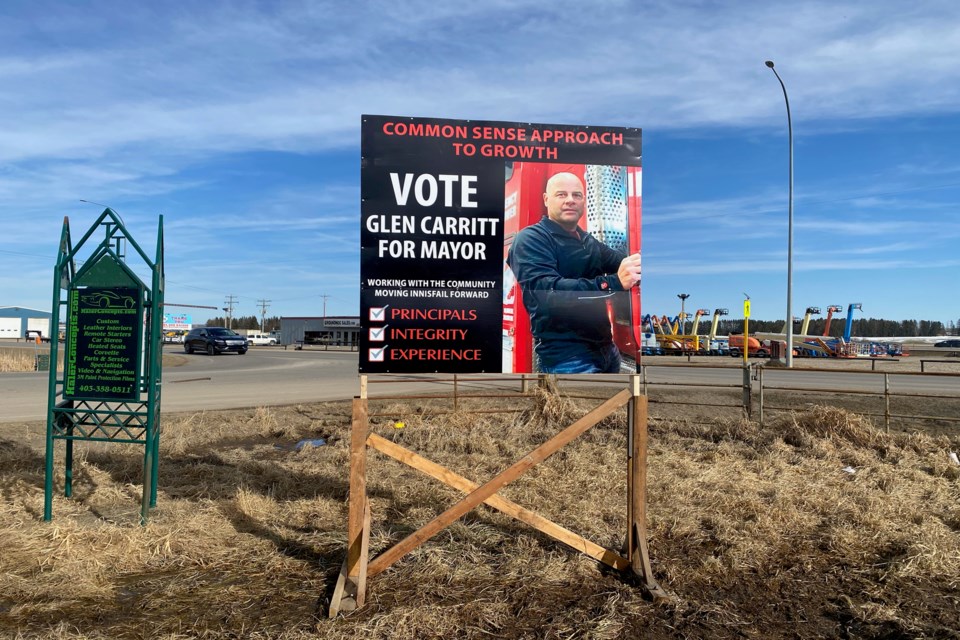INNISFAIL – The town is moving ahead with a new Election Sign Bylaw that will replace an ineffective policy unable to enforce unwanted signs going up across the community almost seven months before October’s general municipal election.
The controversial election sign issue was discussed by council at its regular meeting on March 22, and a motion was unanimously passed for administration to prepare an Election Sign Bylaw and bring it back for council’s consideration.
On March 24, Heather Whymark, the town's director of corporate services and returning officer for the Oct. 18 municipal general election, told The Albertan she will be bringing a draft bylaw containing new election sign regulations and timelines to council on April 12.
“Nobody wants to see election signs for the next six bloody months. It’s that simple,” said Mayor Jim Romane. “It takes away the aesthetics and beautification you are trying to accomplish in your town, and then plaster it with signs. It’s just not right. Forty-five days is ample time to advertise prior to an election.”
The issue arose three weeks ago when mayoralty candidate Glen Carritt announced on social media his election team would begin installing election signs at various private property sites across town. There was at least one Glen Carritt election sign installed outside of town, about one kilometre east along Highway 590.
The news touched off heated online debates and commentary, which included Carritt’s insistence there was approval made for early election sign installation at a council meeting last Dec. 14 when council was asked to approve an updated Election Bylaw to conform with the province’s Local Authorities Election Act.
The updated provincial legislation now allows candidate campaigns to start more than nine months before October's general municipal election. However, the issue of when election signs can go up is left to each municipality.
The town’s current Election Sign Policy, which was last updated in 2017, states election signs can only go up 45 days before the election.
Whymark told council on March 22 the town’s lawyer determined that there was no “legal action” to the policy and no means to enforce it, except when election signs were on town property.
“I can not go on private property,” said Whymark. However, she said there were options available to council.
“A sign bylaw will have some component of compliance. However, not to the degree where we can walk on their (private) property and take it off without going through a court order,” said Whymark, adding an enforcement component, which could include fines, can be added to a new or updated bylaw.
However, she told council it still does not force property owners to take down an illegal sign.
“That doesn’t get them to take it (sign) down,” she said, adding if the town wanted to follow-up it could do so by getting a court-ordered stop order, which could give the town the right to remove a sign from private property.
“There is a method to do it but the timelines, (and) by the time you issue the stop order and how long you get to court and come back I am not sure what that would be,” she said.
Nevertheless, council was united in having administration to create an election sign bylaw, updated or new, that would give the town the legal authority to regulate them and have tougher enforcement measures.
“I would certainly like to see us to do whatever we can to not have a NASCAR looking town for the rest of the summer,” said Coun. Gavin Bates.
Coun. Danny Rieberger said staff should look into what other regional municipalities, like Olds and Red Deer County, are doing with election sign policies or bylaws. He added he would like to see a date of Sept. 1, a full six weeks before an election, when signs are allowed to go up.
“It’s unfortunate we even have to do this. The expectation is that if you have a policy is that people would respect the policy but evidentially that was done in a simpler time when people respected things,” said Rieberger.
Coun. Jean Barclay agreed, adding it was a “shame” the town had to go through the sign controversy as the policy has been in place since 2004.
“I also think it’s about fairness as well. There are people who are going to be running that haven’t even announced yet,” said Barclay, who proposed Sept. 21, the municipal election’s Nomination Day, as a date for candidates to be allowed to put up election signs. “We either have to get rid of the election sign policy because it is not being followed or we go to something different, which is a bylaw.”
In the meantime, Red Deer County’s probe has ended into the Innisfail election sign that was placed in the rural municipality along Highway 590.
Nancy Lougheed, the county’s legislative services manager and returning officer for the upcoming general municipal election, said the county has been “advised” by the candidate on March 22 he was removing the election sign.
“At some point in time when administration is out in the area, they will have a look,” said Lougheed. “Once the property has come into compliance with our Land Use Bylaw then there is nothing further that needs to be done.”
The Albertan attempted to contact Carritt about the apparent removal of his election sign on Highway 590 but a response was not immediately returned.



